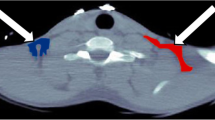Abstract
Lipolysis (the breakdown of fat) is generally estimated using stable isotopes, where the rate of appearance (Ra) of glycerol is calculated using Steele's equations. These equations are based on single-compartment differential equations for tracer and tracee where rate of change is approximated by the change in concentration from one time point to the next. We demonstrate an alternative approach to estimate metabolic processes, and to determine relationships between hormones and their actions. Growth hormone (GH) or saline was administered in a double-blind randomized crossover design to eight normal weight (NW) and eight obese (OB) subjects, and differences in the effects of GH on lipolysis were investigated. The relationship between the plasma GH concentration and glycerol Ra (as an index of lipolysis) was described using PK/PD modeling. The model incorporated the plasma GH, glycerol and D5-glycerol concentration profiles, and two sequential effect compartments to account for the delay in response. The estimated time-profile of glycerol Ra was compared with estimates obtained using Steele's equations. NONMEM (Version V) FOCE was used for parameter estimation, four differential equations were used, and glycerol and D5-glycerol were estimated simultaneously. The model adequately described both primary variables (glycerol) and derived variables (glycerol Ra as obtained using Steele's equations). Modeling allowed the assessment of potential differences in GH sensitivity in the two groups, and indicated the importance of GH in lipolysis.
Similar content being viewed by others
REFERENCES
M. Vaughan. The metabolism of adipose tissue in vitro. J. Lipid Res. 2:293-316 (1961).
M. D. Jensen, V. Heiling, and J. M. Miles. Measurement of non-steady-state free fatty acid turnover. Am. J. Physiol. 258:E103-108 (1990).
J. Rosenblatt and R. R. Wolfe. Calculation of substrate flux using stable isotopes. Am. J. Physiol. 254:E526-531 (1988).
E. J. Wegman and W. Wright. Splines in statistics. J. Am. Statist. Assoc. 78:351-366 (1985).
C. Marcus, V. Margery, A. Kamel, and M. Bronnegard. Effects of growth hormone on lipolysis in humans. Acta Paediatr. Suppl. 406:54-58 (1994).
N. Vahl, J. O. Jorgensen, C. Skjaerbaek, J. D. Veldhuis, H. Orskov, and J. S. Christiansen. Abdominal adiposity rather than age and sex predicts mass and regularity of GH secretion in healthy adults. Am. J. Physiol. 272:E1108-1116 (1997).
A. Gastaldelli, A. R. Coggan, and R. R. Wolfe. Assessment of methods for improving tracer estimation of non-steady-state rate of appearance. J. Appl. Physiol. 87:1813-22 (1999).
R. C. Schoemaker and A. F. Cohen. Estimating impossible curves using NONMEM. Br. J. Clin. Pharmacol. 42:283-290 (1996).
J. Finidori. Regulators of growth hormone signaling. Vitam Horm 59:71-97 (2000).
N. H. G. Holford and L. B. Sheiner. Understanding the dose-effect relationship: clinical application of pharmacokinetic-pharmacodynamic models. Clin. Pharmacokinet. 6:429-453 (1981).
N. L. Dayneka, V. Garg, and W. J. Jusko. Comparison of four basic models of indirect pharmacodynamic responses. J. Pharmacokin. Biopharm. 21:457-478 (1993).
D. Verotta and L. B. Sheiner. A general conceptual model for non-steady state pharmacokinetic _pharmacodynamic data. J. Pharmacokin. Biopharm. 23:1-4 (1995).
Author information
Authors and Affiliations
Corresponding author
Rights and permissions
About this article
Cite this article
Schoemaker, R.C., Buijs, M.M., Pijl, H. et al. Modeling the Influence of Growth Hormone on Lipolysis. J Pharmacokinet Pharmacodyn 29, 157–170 (2002). https://doi.org/10.1023/A:1019803924485
Issue Date:
DOI: https://doi.org/10.1023/A:1019803924485




